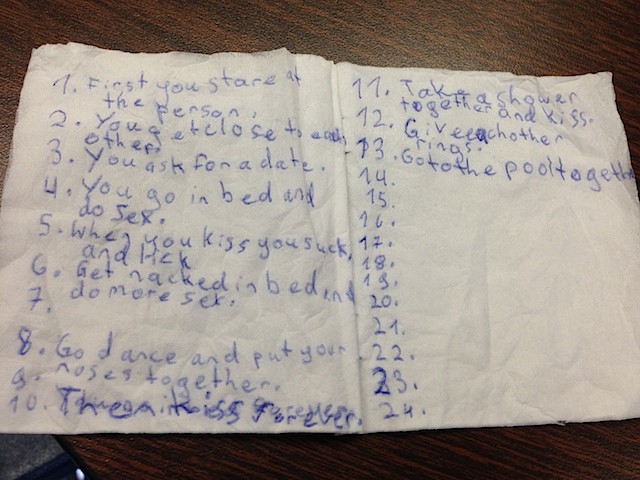Second-Graders Explain The 24 Stages Of True Love
by Matthew J.X. Malady
The best thing you will read all day: two of my sister’s 2nd graders on “how to fall in love.” My favorite: step #8. pic.twitter.com/AfmjcNcNpm
— Ted Scheinman (@Ted_Scheinman) December 21, 2013
People drop things on the Internet and run all the time. So we have to ask.
Ted! So what happened here?
Short answer: the best thing ever.
Longer answer: My sister teaches languages at a school in the northeast and did not actually witness the composition of this masterpiece, but a colleague confides that the two girls (both second-graders) had finished their work about 12 minutes early and decided to write a “book” using napkins (possibly from a classroom birthday party?), with staples for the binding.
“The seats in that class are assigned,” my sister says, “but these two are really good friends, though I wouldn’t say they’re best friends. They play together often during recess — lots of cartwheels and flips and gymnastics in general — and are very popular… or as popular as one can be in second grade.”
My sister’s colleague saw them giggling and went to find the cause. Presumably she expected something less monumental. The girls surrendered the text without a struggle. I don’t believe it was confiscated on account of raciness; we’re pretty sure the teacher just really wanted to keep it.
Based on a close handwriting examination, my sister and I have determined it’s most likely that both young ladies participated in writing the list. If you look very closely, you can see the staple-marks. The cover — which we cannot print here, because it names names — bears the simple title, “How to fall in love.”
The students, I’m told, come from cosmopolitan families, where English is a “first” language but not the only one. This polyglot upbringing may demystify various missing prepositions (e.g., step four).
Anyway, the baby sis and I spent a lot of time analyzing this text on a road trip to visit family for the holidays. I fell instantly in love with the napkin, though the more we look at it, the more we are convinced it’s actually Kleenex, so there may not have been a birthday party after all. The missing portions, or lacunae, in the manuscript leave a lot of delicious questions, as does step nine, which is really a palimpsest-type situation — you can see that it once read: “You go in bed forever.” There’s a variety of interpretations here. Maybe they were just tired after all that dancing?
Frankly, it would take a professional paleographer to tell whether certain missing numbers were left blank intentionally, or out of delicacy, or even which “rules” correlate with which numbers. It’s like the Dead Sea Scrolls except more important. The final 10 items do leave a lot to the imagination.

[Transcript:]
How to fall in love
1. First you stare at the person.
2. You get close to each other
3. You ask for a date.
4. You go in bed and do sex
5. When you kiss you suck and lick
6. Get nacked [sic] in bed and do more sex.
7.
8. Go dance and put your noses together.
9.
10. You go in bed forever Then kiss forever.
11. Take a shower together and kiss.
12. Give each other rings.
13. Go to the pool together.
14.
15.
16.
17.
18.
19.
20.
21.
22.
23.
24.
Are all of these steps meant to be in order? Put another way: Would it be bad to go to the pool with someone without first giving that person a ring?
This is a very important question. It certainly gives new meaning to the notion of “taking the plunge.” There may be portions of Christendom where it would indeed be “bad” to do so.
Or, in my sister’s words: “Swimming before rings is unacceptable.”
Then again, if the rings are inflatable, it could be pretty useful to procure them before swimming.
Really, we should defer the final verdict to John Lingan, father of two, who responded via Twitter: “I always tell my kids, no getting in the pool with someone else until marriage.” (Lingan continued: “It’s an uphill battle, what with the oversaturation of pool-swimming imagery in the media and online.”)
Lessons learned (if any)?
Barring the (ahem) abrupt transition between steps three and four, certain moments in the text strike me as old-fashioned and rather romantic. Consider the dancing of the noses, and the repeated use of the adverb “forever.” True love remains a real, if giggle-inducing, idea for these girls. There may yet be hope for monogamy?
My sister observes, “They never say, ‘I love you,’” but of course we must remember there are at least 10 spots left, and also — well, the title. “Then again,” she muses, “saying it doesn’t make it happen, and may not be the most important part.”
Another point: These youngsters are clearly capitalizing on the current boom in self-publishing. Certainly, their resourcefulness in the use of Kleenex and staples deserves praise. Technologically, it’s a throwback to pre-Gutenberg times, but it also suggests that the post-digital generations still put a premium on face-to-face (or perhaps nose-to-nose) interaction. No mention of Gchat, for example. So, some old-fashioned truths still hold.
Just one more thing?
It seems only natural to ask: “Based on these guidelines, have we ever been in love?”
My sister, after a moment of thought, says, “Apparently not.” As an older brother, I do not press her on the subject — she’s not married, and while her boyfriend is an accomplished rower, I’m not sure whether or how often they swim, touch noses, etc.
As for me, the answer is a disheartening no — the ring being the main disqualifier. Also, I rarely dance like that.
Matthew J.X. Malady is a writer and editor in New York City.
